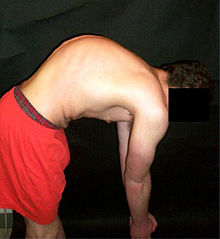
Back Kifose Afrikaans حداب Arabic Kifoz Azerbaijani Кифоза Bulgarian Tort (korf) Breton Cifosi Catalan Kyfóza Czech Kyphose German Κύφωση Greek Cifosis Spanish
| Hyperkyphosis | |
|---|---|
| Other names | Roundback, hunchback |
 | |
| A preoperative image of a 22-year-old man with Scheuermann's disease, a type of structural kyphosis | |
| Specialty | Orthopedics |
Kyphosis is an abnormally excessive convex curvature of the spine as it occurs in the thoracic and sacral regions.[1][2] Abnormal inward concave lordotic curving of the cervical and lumbar regions of the spine is called lordosis. It can result from degenerative disc disease; developmental abnormalities, most commonly Scheuermann's disease; Copenhagen disease, osteoporosis with compression fractures of the vertebra; multiple myeloma; or trauma. A normal thoracic spine extends from the 1st thoracic to the 12th thoracic vertebra and should have a slight kyphotic angle, ranging from 20° to 45°. When the "roundness" of the upper spine increases past 45° it is called kyphosis or "hyperkyphosis". Scheuermann's kyphosis is the most classic form of hyperkyphosis and is the result of wedged vertebrae that develop during adolescence. The cause is not currently known and the condition appears to be multifactorial and is seen more frequently in males than females.[3]
In the sense of a deformity, it is the pathological curving of the spine, where parts of the spinal column lose some or all of their lordotic profile. This causes a bowing of the back, seen as a slouching posture. Kyphosis is distinguished from scoliosis, a condition in which the spine has a sideways curve.
While most cases of kyphosis are mild and only require routine monitoring, serious cases can be debilitating. High degrees of kyphosis can cause severe pain and discomfort, breathing and digestion difficulties, cardiovascular irregularities, neurological compromise and, in the more severe cases, significantly shortened life spans. These types of high-end curves typically do not respond well to conservative treatment and almost always warrant spinal fusion surgery, which can restore the body's natural degree of curvature. The term is from Greek κυφός kyphos, a hump.
- ^ Fon GT, Pitt MJ, Thies AC (May 1980). "Thoracic kyphosis: range in normal subjects". AJR. American Journal of Roentgenology. 134 (5): 979–83. doi:10.2214/ajr.134.5.979. PMID 6768276.
- ^ Voutsinas SA, MacEwen GD (September 1986). "Sagittal profiles of the spine". Clinical Orthopaedics and Related Research (210): 235–42. PMID 3757369.
- ^ "What is Kyphosis?". Your Body Posture. 14 February 2018. Retrieved 14 February 2018.
© MMXXIII Rich X Search. We shall prevail. All rights reserved. Rich X Search